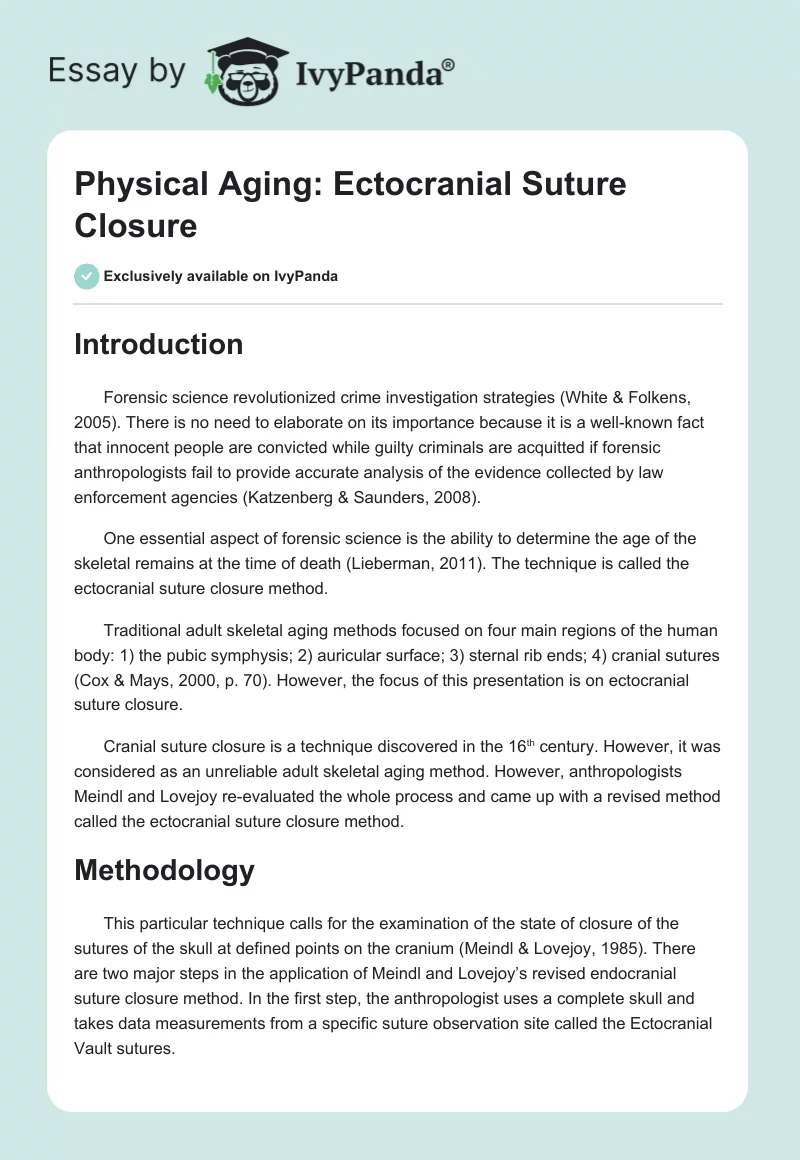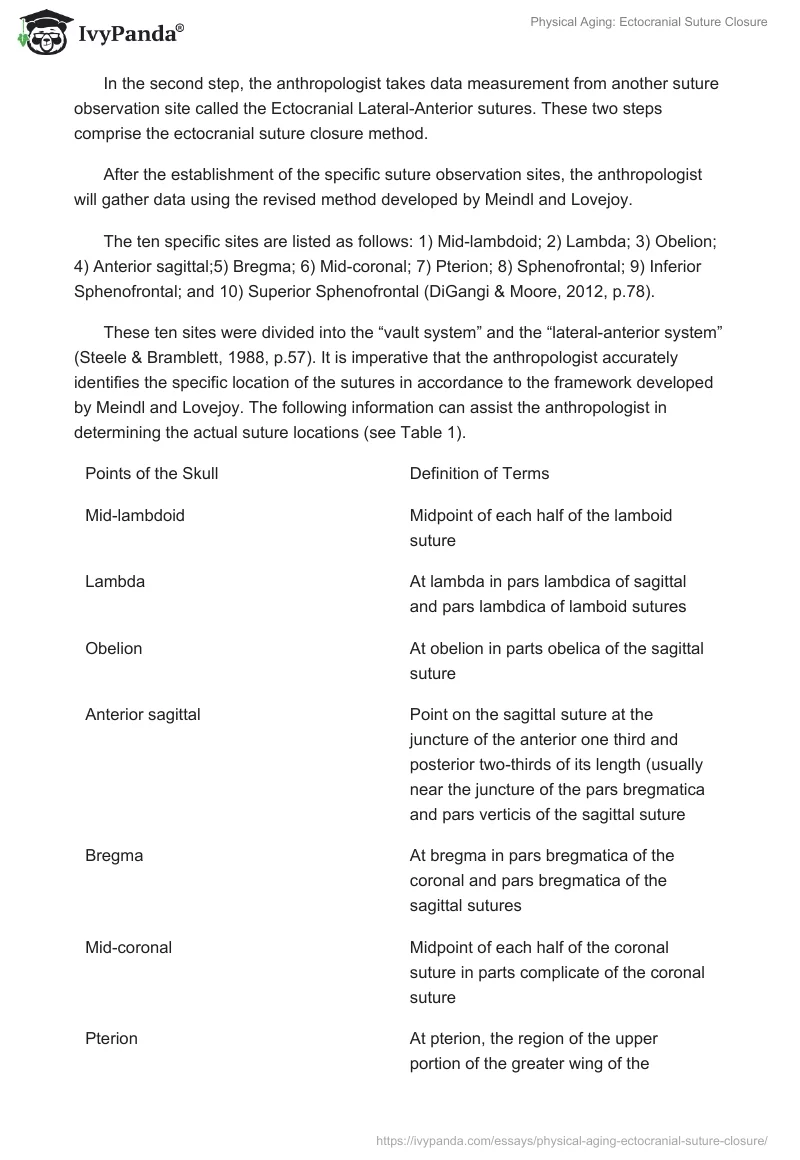Introduction
Forensic science revolutionized crime investigation strategies (White & Folkens, 2005). There is no need to elaborate on its importance because it is a well-known fact that innocent people are convicted while guilty criminals are acquitted if forensic anthropologists fail to provide accurate analysis of the evidence collected by law enforcement agencies (Katzenberg & Saunders, 2008).
One essential aspect of forensic science is the ability to determine the age of the skeletal remains at the time of death (Lieberman, 2011). The technique is called the ectocranial suture closure method.
Traditional adult skeletal aging methods focused on four main regions of the human body: 1) the pubic symphysis; 2) auricular surface; 3) sternal rib ends; 4) cranial sutures (Cox & Mays, 2000, p. 70). However, the focus of this presentation is on ectocranial suture closure.
Cranial suture closure is a technique discovered in the 16th century. However, it was considered as an unreliable adult skeletal aging method. However, anthropologists Meindl and Lovejoy re-evaluated the whole process and came up with a revised method called the ectocranial suture closure method.
Methodology
This particular technique calls for the examination of the state of closure of the sutures of the skull at defined points on the cranium (Meindl & Lovejoy, 1985). There are two major steps in the application of Meindl and Lovejoy’s revised endocranial suture closure method. In the first step, the anthropologist uses a complete skull and takes data measurements from a specific suture observation site called the Ectocranial Vault sutures.
In the second step, the anthropologist takes data measurement from another suture observation site called the Ectocranial Lateral-Anterior sutures. These two steps comprise the ectocranial suture closure method.
After the establishment of the specific suture observation sites, the anthropologist will gather data using the revised method developed by Meindl and Lovejoy.
The ten specific sites are listed as follows: 1) Mid-lambdoid; 2) Lambda; 3) Obelion; 4) Anterior sagittal;5) Bregma; 6) Mid-coronal; 7) Pterion; 8) Sphenofrontal; 9) Inferior Sphenofrontal; and 10) Superior Sphenofrontal (DiGangi & Moore, 2012, p.78).
These ten sites were divided into the “vault system” and the “lateral-anterior system” (Steele & Bramblett, 1988, p.57). It is imperative that the anthropologist accurately identifies the specific location of the sutures in accordance to the framework developed by Meindl and Lovejoy. The following information can assist the anthropologist in determining the actual suture locations (see Table 1).
Table 1. Definitions of suture observation sites.
After the specific locations were identified, the anthropologist uses a four-point scoring system. The scoring system uses the following criteria: 0 = no observable closure; 1 = minimal closure; 2 = significant closure; and 3 = complete obliteration (DiGangi & Moore, 2012, p.78).
After observing the ten specific sites, the anthropologist will use a table of composite scores and a mean age and standard deviation for each score (DiGangi & Moore, 2012, p.79). The anthropologist compares the values generated and uses the table to determine the estimated age of the skeleton.
Research Findings
The ectocranial suture closure technique should become one of the major age determination techniques made available to anthropologists. The technique is based on a reliable framework. It is advantageous to use this particular technique especially when it comes to determining the age group.
Moreover, this technique provides the capability to determine the age of the skeleton if other techniques are non-available. At the same time this technique can be used to validate age estimated generated by other techniques.
The ectocranial suture closure can help provide an age estimate of the skeletal remains. But scientists are unable to provide a clear explanation when it comes to the correlation of suture closure and age. Another major disadvantage of this technique is the broad age intervals. The broad range intervals can be a problem when it comes to forensics.
Forensic anthropologists are faced with the challenge to provide accurate estimates of age while taking into consideration human variation in the aging process (Dirkmaat, 2012 p. 203).
According to one commentary, “the narrower, or more precise the age estimate given, the more helpful it can be to law enforcement when eliminating possible identities” (Dirkmaat, 2012 p.203). Critics are quick to point out that this particular technique is an unreliable skeletal aging method (Meindl & Lovejoy, 1985 p. 57).
Detractors rejected cranial suture closure and remarked that it cannot be trusted (Meindl & Lovejoy, 1985, p. 57). Nevertheless, after an in-depth study on different techniques, it was discovered that “no single skeletal indicator of age at death is ever likely to accurately reflect the many factors which accumulate with chronological age, each of which contribute valuable information to the age estimate” (Meindl & Lovejoy, 1985, p. 65).
It o therefore important to useIt is therefore imperative to reconsider the value of the ectocranial suture closure as an alternative tool in the determination of the age of the skeleton at the time of death.
Conclusion
The ectocranial suture closure technique is not reliable when it comes to precise age estimates. Anthropologists said that there are broad age intervals. At the same time they cannot provide a clear explanation with regards to the correlation between suture closure and age of the skeleton.
But this technique is useful when it comes to the determination of age groups, whether the skeleton belongs to a child or an adult. Furthermore, this technique is useful when it comes to the validation of age estimates provided by other skeletal age determination techniques.
References
Cox, M & Mays, S 2000, Human osteology: in archaeology and forensic science, Oxford University Press, UK.
DiGangi, E & Moore, M 2012, Research methods in human skeletal biology, Academic Press, UK.
Dirkmaat, D 2012, A companion to forensic anthropology, Blackwell Publishing, UK.
Katzenberg, M & Saunders, S 2008, Biological anthropology of the human skeleton, John Wiley & Sons, New Jersey.
Lieberman, D 2011, The evolution of the human head, Harvard University Press, MA.
Meindl, R & Lovejoy, O1985, ‘Ectocranial suture closure: a revised method for the determination of skeletal age at death based on the lateral-anterior sutures’, The American Journal of Physical Anthropology, vol. 68 no.1, pp. 57-66.
Steele, D & C Bramblett, 1988, The anatomy and biology of the human skeleton, Texas A & M University Press, TX.
White, T & Folkens, P, 2005, The human bone manual, Elsevier Academic Press, UK.


